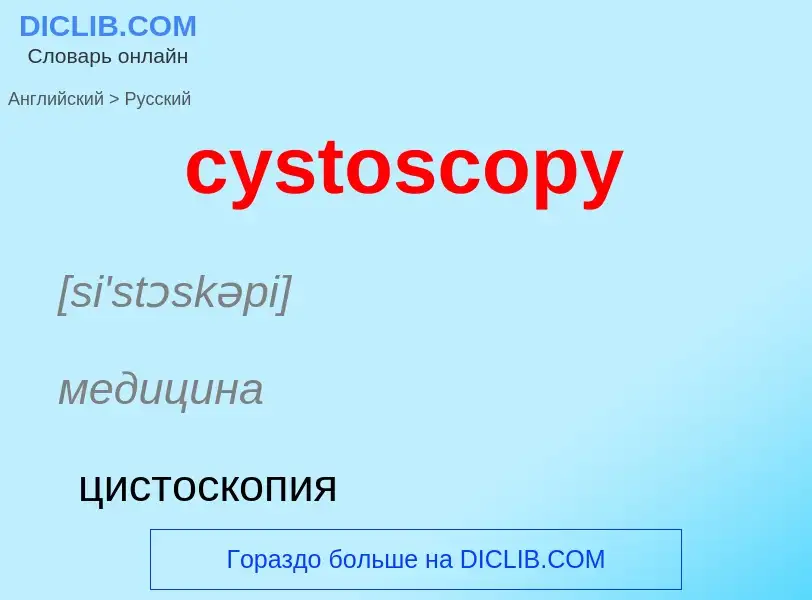Vertaling en analyse van woorden door kunstmatige intelligentie
Op deze pagina kunt u een gedetailleerde analyse krijgen van een woord of zin, geproduceerd met behulp van de beste kunstmatige intelligentietechnologie tot nu toe:
- hoe het woord wordt gebruikt
- gebruiksfrequentie
- het wordt vaker gebruikt in mondelinge of schriftelijke toespraken
- opties voor woordvertaling
- Gebruiksvoorbeelden (meerdere zinnen met vertaling)
- etymologie
cystoscopy - vertaling naar russisch
[si'stɔskəpi]
медицина
цистоскопия
существительное
медицина
цистоскопия
['sistəskəup]
медицина
цистоскоп
существительное
общая лексика
цистоскоп
медицина
цистоуретроскопия
Definitie
Wikipedia
Cystoscopy is endoscopy of the urinary bladder via the urethra. It is carried out with a cystoscope.
The urethra is the tube that carries urine from the bladder to the outside of the body. The cystoscope has lenses like a telescope or microscope. These lenses let the physician focus on the inner surfaces of the urinary tract. Some cystoscopes use optical fibres (flexible glass fibres) that carry an image from the tip of the instrument to a viewing piece at the other end. Cystoscopes range from pediatric to adult and from the thickness of a pencil up to approximately 9 mm and have a light at the tip. Many cystoscopes have extra tubes to guide other instruments for surgical procedures to treat urinary problems.
There are two main types of cystoscopy—flexible and rigid—differing in the flexibility of the cystoscope. Flexible cystoscopy is carried out with local anaesthesia on both sexes. Typically, a topical anesthetic, most often xylocaine gel (common brand names are Anestacon and Instillagel) is employed. The medication is instilled into the urethra via the urinary meatus five to ten minutes prior to the beginning of the procedure. Rigid cystoscopy can be performed under the same conditions, but is generally carried out under general anesthesia, particularly in male subjects, due to the pain caused by the probe. The sizes of the sheath of the rigid cystoscope are 17 French gauge (5.7 mm diameter), 19 Fr gauge (6.3 mm diameter), and 22 Fr gauge (7.3 mm diameter).

![A sterile flexible cystoscope in an [[operating theatre]] A sterile flexible cystoscope in an [[operating theatre]]](https://commons.wikimedia.org/wiki/Special:FilePath/Cystoscope-med-20050425.jpg?width=200)
